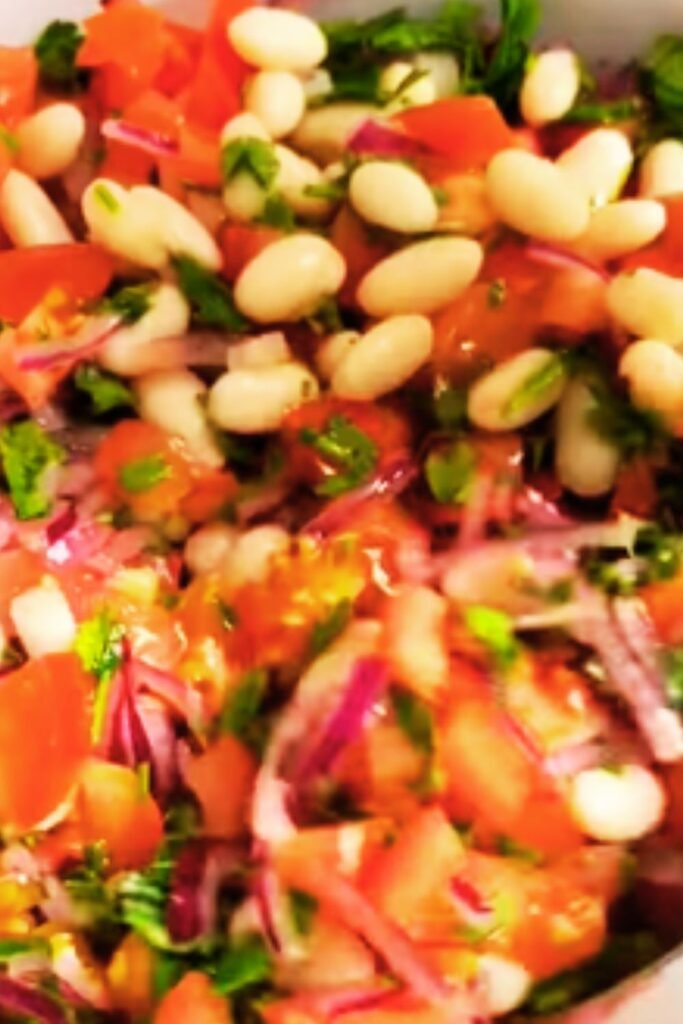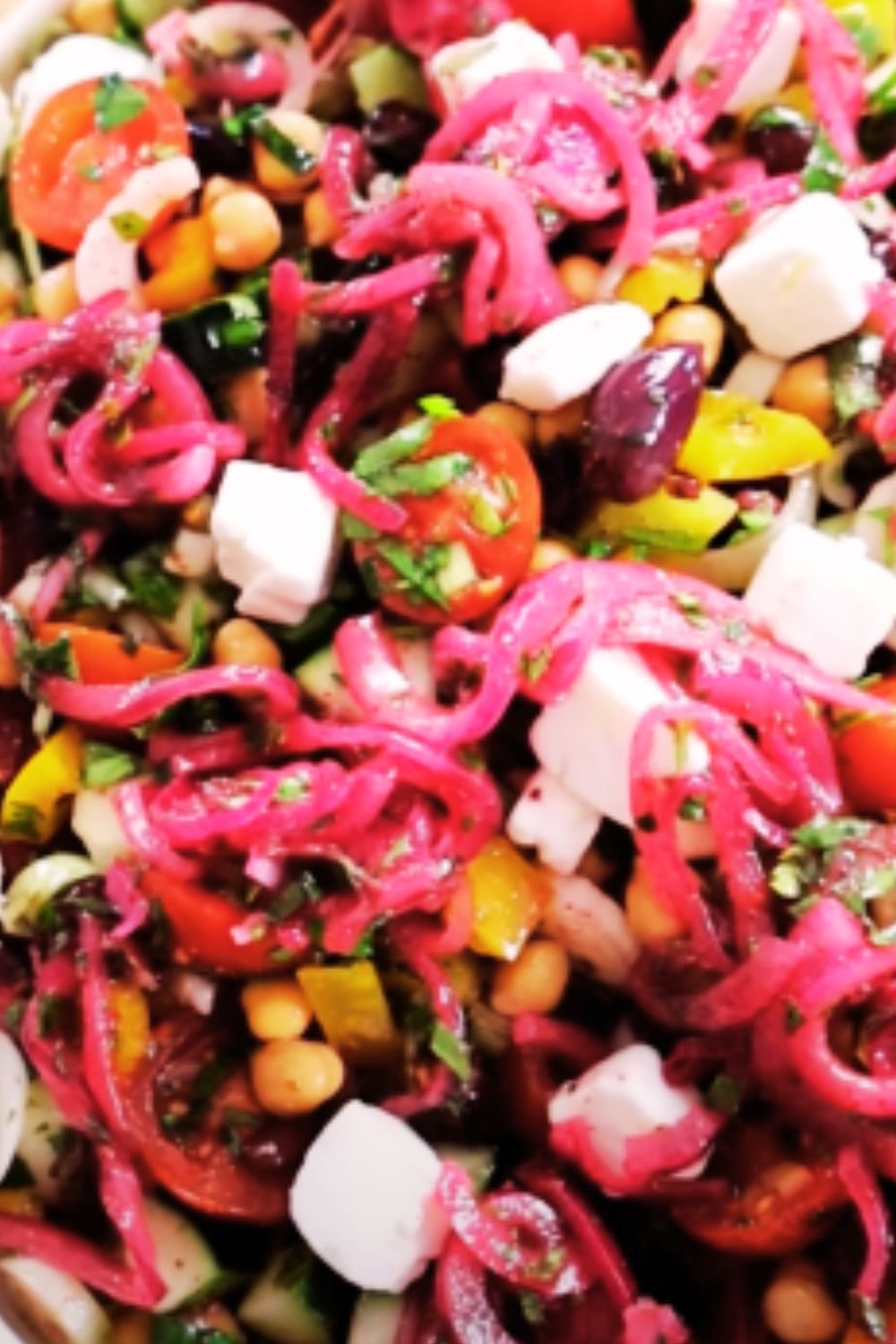There’s something magical about discovering a dish that’s simultaneously simple and complex, traditional yet adaptable. Piyaz, the beloved Turkish white bean salad, is precisely that kind of culinary treasure. As someone who’s spent years exploring Mediterranean cuisine, I can confidently say that piyaz deserves a permanent spot in your recipe collection.
The first time I encountered authentic piyaz was during a culinary tour through Turkey’s southern coast. In Antalya, where the regional variation includes a special tahini-based dressing, I watched in awe as this humble bean salad was transformed into something extraordinary. The contrast of creamy white beans against vibrant herbs, tangy sumac, and sharp red onions created a visual feast that matched its incredible flavor profile.
In this comprehensive guide, I’ll walk you through everything you need to know about creating authentic Turkish piyaz at home, including regional variations, preparation techniques, and serving suggestions that will elevate your dining experience.
What is Piyaz?
Piyaz is a traditional Turkish salad consisting primarily of white beans (typically cannellini or navy beans), mixed with fresh vegetables and dressed with olive oil and vinegar or lemon juice. The word “piyaz” comes from Persian, where it originally referred to onions, highlighting the importance of this ingredient in the dish.
While often served as a side dish, piyaz has enough substance and protein to function as a light meal on its own. It’s particularly popular in Turkey’s Mediterranean and Aegean regions, with each area adding its own distinctive touch to the basic recipe.
Regional Variations of Piyaz
- Antalya Piyaz: Perhaps the most famous variation, distinguished by its creamy tahini-based dressing and often served with boiled eggs.
- Black Sea Piyaz: Features more herbs, particularly dill and parsley, and sometimes includes locally caught anchovies.
- Central Anatolian Piyaz: Typically simpler with fewer ingredients but often includes cumin for added warmth.
- Aegean Piyaz: Incorporates more olive oil and sometimes features olives and capers.
Health Benefits of Piyaz
Before diving into the recipe, it’s worth noting the impressive nutritional profile of this traditional dish:
| Nutrient | Benefit | Source in Piyaz |
|---|---|---|
| Plant Protein | Muscle repair, satiety | White beans |
| Dietary Fiber | Digestive health, blood sugar regulation | White beans, vegetables |
| Monounsaturated Fats | Heart health, inflammation reduction | Olive oil |
| Vitamin C | Immune support, collagen production | Tomatoes, parsley |
| Vitamin K | Bone health, blood clotting | Parsley, onions |
| Iron | Oxygen transport, energy production | White beans, parsley |
| Folate | Cell division, DNA synthesis | White beans |
| Antioxidants | Cell protection, anti-aging | Herbs, olive oil, vegetables |
What I love most about piyaz is that it’s not just delicious—it’s genuinely good for you. The combination of beans and olive oil provides a perfect balance of plant protein and healthy fats, making it incredibly satisfying.
Essential Ingredients for Authentic Piyaz
For the most authentic experience, I recommend seeking out these ingredients:
- White Beans: Cannellini beans (also called white kidney beans) are traditional, but navy beans or great northern beans work well too.
- Red Onions: These provide the distinctive sharp flavor and beautiful color contrast.
- Fresh Herbs: Flat-leaf parsley is essential; mint, dill, or cilantro can be added depending on your preference.
- Tomatoes: Firm, ripe tomatoes add juiciness and acidity.
- Eggs: Traditional in many regions, particularly Antalya.
- Sumac: This tangy, bright red spice is quintessentially Middle Eastern and adds a lemony flavor.
- Quality Olive Oil: Use the best extra virgin olive oil you can afford—it makes a significant difference.
- Lemon Juice or Vinegar: White wine vinegar is common, but lemon juice gives a fresher taste.
- Tahini: Essential for Antalya-style piyaz.
Traditional Piyaz Recipe
Here’s my carefully crafted recipe that stays true to the traditional preparation while being accessible for home cooks.
Ingredients:
For the salad:
- 2 cups cooked white beans (from 1 cup dried, or 2 cans, drained and rinsed)
- 1 medium red onion, thinly sliced
- 2 medium tomatoes, diced
- 1 cucumber, diced (optional)
- 1 cup fresh parsley, chopped
- 1/4 cup fresh mint, chopped (optional)
- 3-4 hard-boiled eggs, quartered (optional)
For the dressing:
- 1/3 cup extra virgin olive oil
- 3 tablespoons lemon juice (or white wine vinegar)
- 2 tablespoons tahini (for Antalya-style)
- 1 teaspoon sumac, plus more for garnish
- 1 teaspoon salt
- 1/2 teaspoon freshly ground black pepper
- 1/2 teaspoon ground cumin (optional)
- 1 clove garlic, minced (optional)
Instructions:
- If using dried beans: Soak them overnight in cold water. Drain, place in a pot with fresh water, and simmer until tender but not mushy (about 45-60 minutes). Drain and cool.
- Prepare the onions: Place sliced onions in a bowl of cold water with a pinch of salt for 10-15 minutes. This reduces the sharpness while maintaining crispness. Drain well and pat dry.
- Make the dressing: In a small bowl, whisk together olive oil, lemon juice, tahini (if using), sumac, salt, pepper, cumin (if using), and garlic (if using) until emulsified.
- Assemble the salad: In a large bowl, combine the cooled beans, prepared onions, diced tomatoes, cucumber (if using), and herbs.
- Finish the dish: Pour the dressing over the salad and gently toss to combine. Arrange the eggs around the edges if using. Sprinkle with additional sumac for color and flavor.
- Rest and serve: Allow the salad to rest for at least 30 minutes before serving to let the flavors meld. Serve at room temperature.

Cooking Tips from My Kitchen to Yours
Through years of preparing this dish, I’ve collected some invaluable tips that make a world of difference:
- Bean Preparation: For the best texture, cook your own beans rather than using canned. If you must use canned, rinse them thoroughly and allow them to dry slightly before adding to the salad.
- Dressing Techniques: Add the dressing while the beans are still slightly warm (not hot). This allows them to absorb the flavors more effectively.
- Onion Treatment: Soaking sliced onions in ice water with a pinch of salt for 10-15 minutes before adding them to the salad reduces their sharpness while keeping them crisp.
- Herb Handling: Chop herbs just before adding them to maintain their vibrant color and aroma.
- Egg Incorporation: For traditional Antalya-style piyaz, eggs shouldn’t be mixed in but rather arranged around the edges of the salad.
- Resting Period: Allow the salad to rest for at least 30 minutes before serving to develop the fullest flavor profile.
Make-Ahead and Storage Recommendations
One of the reasons I love piyaz is its practicality. Here’s how to make the most of it:
- Make-Ahead: Piyaz actually improves with time, making it an excellent make-ahead dish. Prepare it up to 24 hours in advance, but add the herbs just before serving to keep them vibrant.
- Storage: Store leftover piyaz in an airtight container in the refrigerator for up to 3 days. The flavors will continue to develop, though the vegetables will soften somewhat.
- Refreshing Leftovers: To revitalize day-old piyaz, bring it to room temperature, add a splash of olive oil and lemon juice, and toss in some fresh herbs.
Serving Suggestions and Complete Meals
In Turkey, piyaz is rarely served in isolation. Here are some authentic serving suggestions:
Traditional Pairings
- Köfte: Grilled or pan-fried Turkish meatballs are the classic companion to piyaz.
- Grilled Meats: Especially lamb or beef skewers.
- Lahmacun: A thin Turkish flatbread topped with minced meat.
- Fresh Bread: Warm, crusty bread is essential for soaking up the delicious dressing.
Complete Menu Ideas
Casual Family Dinner:
- Antalya-style Piyaz
- Grilled Köfte
- Bulgur Pilaf
- Fresh Bread
- Turkish Yogurt Drink (Ayran)
Vegetarian Feast:
- Traditional Piyaz with Eggs
- Stuffed Grape Leaves (Dolma)
- Eggplant Salad (Patlıcan Salatası)
- Fava Bean Puree (Fava)
- Turkish Flatbread
Elegant Dinner Party:
- Piyaz with Fresh Herbs and Sumac
- Lamb Kebabs with Yogurt Sauce
- Pomegranate-Glazed Vegetables
- Turkish Rice Pilaf
- Baklava for Dessert

Adapting Piyaz to Dietary Needs
One of the beautiful aspects of piyaz is its natural adaptability to various dietary requirements:
Vegan Adaptation
Traditional piyaz is nearly vegan already—simply omit the eggs and ensure your tahini is pure (no additives). The protein-rich beans make this a satisfying vegan main dish.
Gluten-Free Option
Piyaz is naturally gluten-free, making it an excellent choice for those with celiac disease or gluten sensitivity. Just ensure that any prepared ingredients (like canned beans) don’t contain hidden gluten.
Low-Sodium Version
For those watching sodium intake, use dried beans cooked without salt instead of canned, and adjust the dressing by reducing salt and adding more herbs and lemon zest for flavor.
Modern Twists on Traditional Piyaz
While I’m a staunch advocate for traditional preparations, these contemporary variations can be delightful:
- Mediterranean Fusion: Add olives, capers, and feta cheese for a Greek-Turkish fusion.
- Grain Incorporation: Mix in cooked bulgur, quinoa, or freekeh for a heartier dish.
- Seasonal Adaptations: Incorporate seasonal vegetables like roasted red peppers in summer or roasted butternut squash in fall.
- Herb Variations: Experiment with different herb combinations like cilantro and mint for a fresh take.
Cultural Significance and Traditions
In Turkish culture, piyaz holds a special place beyond its nutritional value:
- Regional Pride: In Antalya, piyaz is considered a point of cultural pride, with restaurants specializing exclusively in köfte and piyaz.
- Communal Dining: The dish exemplifies the Turkish tradition of sharing food, often served family-style in the center of the table.
- Seasonal Celebrations: During summer harvests, freshly picked beans are celebrated with piyaz preparations throughout agricultural regions.
- Historical Significance: Piyaz has roots in Ottoman palace cuisine, demonstrating how even humble ingredients can be elevated to exceptional dishes.
Troubleshooting Common Piyaz Problems
Even experienced cooks encounter challenges with this seemingly simple dish. Here are solutions to common issues:
- Beans Too Firm: Extend cooking time or return dressed beans to low heat for 5 minutes.
- Beans Too Mushy: Use fresh beans and be vigilant about cooking time. For canned beans, handle gently when mixing.
- Too Acidic: Balance with a pinch of sugar or more tahini.
- Too Bland: Add more sumac, salt, or a touch of garlic.
- Watery Dressing: Ensure vegetables are well-drained and consider adding a teaspoon of Dijon mustard to help emulsify the dressing.

Frequently Asked Questions About Piyaz
Q: Can I use different types of beans for piyaz? While cannellini or navy beans are traditional, you can experiment with other white beans. I’ve made excellent variations with butter beans (lima beans) for a creamier texture. Avoid colored beans as they’ll change the dish’s traditional appearance.
Q: How can I reduce the gaseous effects of beans? This is a practical concern! If cooking dried beans, discard the soaking water and use fresh water for cooking. Adding a bay leaf or a piece of kombu seaweed during cooking can also help break down the indigestible sugars. Thoroughly rinsing canned beans helps too.
Q: Is piyaz served hot or cold? Traditional piyaz is served at room temperature. Chilled piyaz loses some of its nuanced flavors, while hot piyaz would wilt the fresh herbs and vegetables.
Q: Can piyaz be a main dish? Absolutely! With its protein-rich beans and healthy fats from olive oil, piyaz can certainly stand alone as a light main course. I often enjoy it this way for lunch, perhaps with some crusty bread on the side.
Q: How long does piyaz keep in the refrigerator? Properly stored in an airtight container, piyaz will keep for 3-4 days. The flavors often improve after a day, though the vegetables will soften somewhat.
Q: Is there a quick version if I don’t have time to soak and cook dried beans? Yes! Use canned beans, rinsed well and patted dry. The flavor won’t be quite as developed as with home-cooked beans, but it’s still delicious and cuts preparation time significantly.
Q: What can I substitute for sumac if I can’t find it? While sumac’s bright, lemony flavor is distinctive, you can substitute a combination of lemon zest and a touch of paprika for color. Za’atar spice blend (which contains sumac) can also work if you have it available.
Final Thoughts
Piyaz exemplifies what I love most about Mediterranean cuisine—simple, fresh ingredients combined thoughtfully to create something far greater than the sum of its parts. This humble white bean salad connects us to centuries of culinary tradition while remaining perfectly relevant to contemporary tastes and nutritional needs.
What makes piyaz truly special is its accessibility. You don’t need specialized equipment or hard-to-find ingredients to create an authentic version that would make any Turkish grandmother proud. Yet within this simplicity lies tremendous opportunity for personal expression through subtle variations in preparation technique and ingredient ratios.
As you incorporate piyaz into your own culinary repertoire, I encourage you to respect its traditions while allowing your personal preferences to guide slight adaptations. The best version of piyaz isn’t found in a specific recipe—it’s the one that brings you and your loved ones the most joy around the table.
Whether you’re serving it alongside köfte at a summer barbecue or enjoying it as a protein-rich lunch on its own, piyaz offers a delicious glimpse into Turkey’s rich culinary heritage that I hope you’ll treasure as much as I do.


